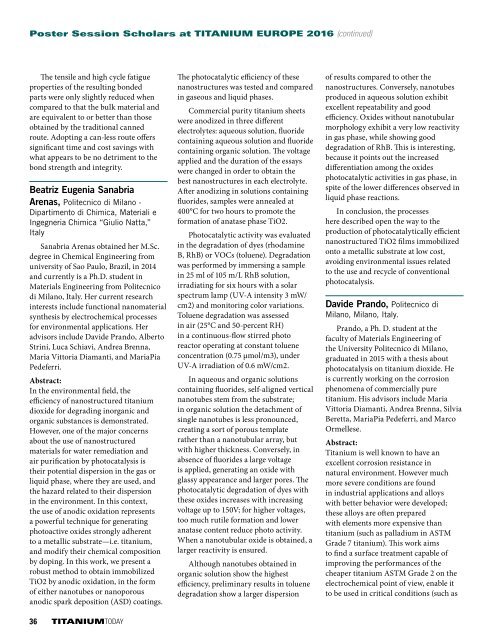100% Positive Material Identification
23mhiW2
23mhiW2
Create successful ePaper yourself
Turn your PDF publications into a flip-book with our unique Google optimized e-Paper software.
Poster Session Scholars at TITANIUM EUROPE 2016 (continued)<br />
The tensile and high cycle fatigue<br />
properties of the resulting bonded<br />
parts were only slightly reduced when<br />
compared to that the bulk material and<br />
are equivalent to or better than those<br />
obtained by the traditional canned<br />
route. Adopting a can-less route offers<br />
significant time and cost savings with<br />
what appears to be no detriment to the<br />
bond strength and integrity.<br />
Beatriz Eugenia Sanabria<br />
Arenas, Politecnico di Milano -<br />
Dipartimento di Chimica, <strong>Material</strong>i e<br />
Ingegneria Chimica “Giulio Natta,”<br />
Italy<br />
Sanabria Arenas obtained her M.Sc.<br />
degree in Chemical Engineering from<br />
university of Sao Paulo, Brazil, in 2014<br />
and currently is a Ph.D. student in<br />
<strong>Material</strong>s Engineering from Politecnico<br />
di Milano, Italy. Her current research<br />
interests include functional nanomaterial<br />
synthesis by electrochemical processes<br />
for environmental applications. Her<br />
advisors include Davide Prando, Alberto<br />
Strini, Luca Schiavi, Andrea Brenna,<br />
Maria Vittoria Diamanti, and MariaPia<br />
Pedeferri.<br />
Abstract:<br />
In the environmental field, the<br />
efficiency of nanostructured titanium<br />
dioxide for degrading inorganic and<br />
organic substances is demonstrated.<br />
However, one of the major concerns<br />
about the use of nanostructured<br />
materials for water remediation and<br />
air purification by photocatalysis is<br />
their potential dispersion in the gas or<br />
liquid phase, where they are used, and<br />
the hazard related to their dispersion<br />
in the environment. In this context,<br />
the use of anodic oxidation represents<br />
a powerful technique for generating<br />
photoactive oxides strongly adherent<br />
to a metallic substrate—i.e. titanium,<br />
and modify their chemical composition<br />
by doping. In this work, we present a<br />
robust method to obtain immobilized<br />
TiO2 by anodic oxidation, in the form<br />
of either nanotubes or nanoporous<br />
anodic spark deposition (ASD) coatings.<br />
36 TITANIUMTODAY<br />
The photocatalytic efficiency of these<br />
nanostructures was tested and compared<br />
in gaseous and liquid phases.<br />
Commercial purity titanium sheets<br />
were anodized in three different<br />
electrolytes: aqueous solution, fluoride<br />
containing aqueous solution and fluoride<br />
containing organic solution. The voltage<br />
applied and the duration of the essays<br />
were changed in order to obtain the<br />
best nanostructures in each electrolyte.<br />
After anodizing in solutions containing<br />
fluorides, samples were annealed at<br />
400°C for two hours to promote the<br />
formation of anatase phase TiO2.<br />
Photocatalytic activity was evaluated<br />
in the degradation of dyes (rhodamine<br />
B, RhB) or VOCs (toluene). Degradation<br />
was performed by immersing a sample<br />
in 25 ml of 105 m/L RhB solution,<br />
irradiating for six hours with a solar<br />
spectrum lamp (UV-A intensity 3 mW/<br />
cm2) and monitoring color variations.<br />
Toluene degradation was assessed<br />
in air (25°C and 50-percent RH)<br />
in a continuous-flow stirred photo<br />
reactor operating at constant toluene<br />
concentration (0.75 µmol/m3), under<br />
UV-A irradiation of 0.6 mW/cm2.<br />
In aqueous and organic solutions<br />
containing fluorides, self-aligned vertical<br />
nanotubes stem from the substrate;<br />
in organic solution the detachment of<br />
single nanotubes is less pronounced,<br />
creating a sort of porous template<br />
rather than a nanotubular array, but<br />
with higher thickness. Conversely, in<br />
absence of fluorides a large voltage<br />
is applied, generating an oxide with<br />
glassy appearance and larger pores. The<br />
photocatalytic degradation of dyes with<br />
these oxides increases with increasing<br />
voltage up to 150V; for higher voltages,<br />
too much rutile formation and lower<br />
anatase content reduce photo activity.<br />
When a nanotubular oxide is obtained, a<br />
larger reactivity is ensured.<br />
Although nanotubes obtained in<br />
organic solution show the highest<br />
efficiency, preliminary results in toluene<br />
degradation show a larger dispersion<br />
of results compared to other the<br />
nanostructures. Conversely, nanotubes<br />
produced in aqueous solution exhibit<br />
excellent repeatability and good<br />
efficiency. Oxides without nanotubular<br />
morphology exhibit a very low reactivity<br />
in gas phase, while showing good<br />
degradation of RhB. This is interesting,<br />
because it points out the increased<br />
differentiation among the oxides<br />
photocatalytic activities in gas phase, in<br />
spite of the lower differences observed in<br />
liquid phase reactions.<br />
In conclusion, the processes<br />
here described open the way to the<br />
production of photocatalytically efficient<br />
nanostructured TiO2 films immobilized<br />
onto a metallic substrate at low cost,<br />
avoiding environmental issues related<br />
to the use and recycle of conventional<br />
photocatalysis.<br />
Davide Prando, Politecnico di<br />
Milano, Milano, Italy.<br />
Prando, a Ph. D. student at the<br />
faculty of <strong>Material</strong>s Engineering of<br />
the University Politecnico di Milano,<br />
graduated in 2015 with a thesis about<br />
photocatalysis on titanium dioxide. He<br />
is currently working on the corrosion<br />
phenomena of commercially pure<br />
titanium. His advisors include Maria<br />
Vittoria Diamanti, Andrea Brenna, Silvia<br />
Beretta, MariaPia Pedeferri, and Marco<br />
Ormellese.<br />
Abstract:<br />
Titanium is well known to have an<br />
excellent corrosion resistance in<br />
natural environment. However much<br />
more severe conditions are found<br />
in industrial applications and alloys<br />
with better behavior were developed;<br />
these alloys are often prepared<br />
with elements more expensive than<br />
titanium (such as palladium in ASTM<br />
Grade 7 titanium). This work aims<br />
to find a surface treatment capable of<br />
improving the performances of the<br />
cheaper titanium ASTM Grade 2 on the<br />
electrochemical point of view, enable it<br />
to be used in critical conditions (such as







